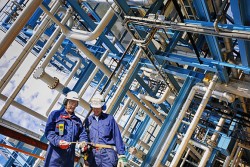It is often said that the worst place to build anything is a building site – our industry just happens to do it pretty well. We have adapted well to the uncertainties thrown up by site-based projects and have been able to show flexibility when responding to technical challenges that need to be solved ‘on the spot’.
However, the complex logistics, difficult working environments and complicated site management that are all fundamental parts of construction projects can make achieving quality construction difficult and they are not particularly enticing for potential new recruits to the industry. The fact that we can now manufacture and test building engineering systems in factory conditions that are safer and more controlled is delivering huge benefits and driving progress.
In some projects, more than 75% of the work is now being carried out offsite and this can deliver significant benefits in terms of time and cost savings. According to a long-term study carried out by the RICS, offsite projects have a 94% on budget success rate compared to 49% for traditional construction and 96% of them are on time compared to 63% for more conventional projects.
Pioneers
Building engineering services specialists understand offsite better than most. After all, ventilation ductwork contractors were the ultimate prefabrication pioneers and have been building their systems offsite since the 19th Century. Today, offsite work includes almost every type of building service from packaged plant rooms and boiler houses to air handling plant and water services. Toilet/bathroom pods, integrated ceiling modules, pump sets, pre-assembled wiring, HVAC distribution systems and prefabricated window units incorporating trickle ventilation are tried and tested and widely deployed.
The mistake is in thinking it can replace all of our processes and replicate all of the finely honed skills required to ensure all of the components come together onsite to make the finished building work. Offsite is a good way of addressing some of our skills shortages, improving productivity and bearing down on rising costs in our supply chains, but onsite work and re-work will always be part of complex construction projects. Having said that we are not ignoring the government’s growing enthusiasm for offsite. However, it is not easy to get offsite projects right and it is certainly not the panacea that some seem to think. The secret of successful prefabrication is having extremely accurate upfront design, which is still something of a work in progress for the construction industry.
The move to Level 3 BIM as part of the ‘Digital Built Britain’ programme could deliver the greater accuracy of design models needed to embed offsite fabrication more successfully into contractors’ way of working, but that reality still lies somewhere in the future. More can (and should) be done offsite than is the current norm and it is important to acknowledge that the Government believes reducing the cost of house building is important and that moving production offsite can achieve this – even though it is just one factor hindering expansion of the market. Our industry needs, therefore, to be ready and able to embrace this way of working wherever it makes sense.
Prefabrication definitely has merits and creates opportunities to improve efficiency, but it is not – on its own – the answer to all the problems in construction supply chains. Nor is it likely to deliver one million new homes.
Excitement
For all the excitement around offsite, progress has been slow and only a relatively small number of clients have recognised the importance of establishing direct links with the offsite supply chain. This is particularly important if you are looking to deliver mechanical, electrical and plumbing services offsite because they require early input from specialist engineers to get the designs right.
How these services are procured is critical and, if offsite is to increase its market share, the tender process has to include a detailed plan for how many and what type of man-hours are to be transferred from the site to the factory. Change is happening, but it is not universal across all market sectors because many people are struggling to get the financial models right which means they will, inevitably, revert to type and seek to procure in the traditional way. If you attempt that with off-site modules you can get into serious difficulties.
However, the infrastructure and housebuilding sectors at the heart of post-Brexit government strategy are particularly ripe for this change and the building engineering sector is ready to respond. Our technical understanding of the different approaches to offsite fabrication is improving all the time and, at BESA, we have technical guidance (TR/39) produced in partnership with Buildoffsite that can help contractors get this right.
It is available here: https://www.besapublications.com/Ecommerce/productPDFs/TR39.pdf
As our understanding of this discipline improves, the section of the Guide currently proving most useful to BESA members is the one that explains when to use offsite; which projects are best suited to this approach and importantly, when the traditional site-based system is still the most appropriate.
For more information visit: www.thebesa.com
Source: Offsite Magazine - Issue 5









